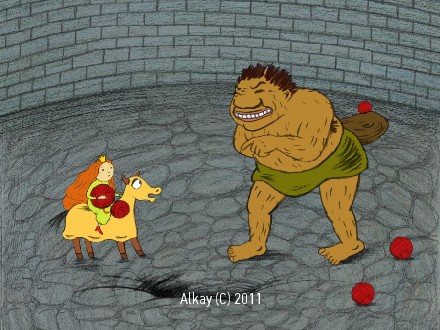In-Dependent Women Cartoonists: The Reality of Original Cartoon Making By Women Artists

In many respects, it is as difficult for women cartoonists to establish themselves in the field of independent animated film today as it was for women to become writers at the beginning of the 20th century. As Virginia Woolf depicted it in her famous essay "A Room of One's Own", certain criteria had to be met for a woman to be able to write. Women cartoonists nowadays also need money and a room of their own or, more precisely, "some money" and an animation desk. Money and the desk represent the first step to making a cartoon, even a very short one.
We can almost say that the only other thing a woman cartoonist needs is a zen-like portion of patience, endurance, modesty and personal determination. However, even the relatively little money one needs to make a cartoon (in contrast to films using actors or other feature-length audiovisual pieces) has been hard to find in recent years (since the 1990's). Original cartoons, which are usually several minutes long (and thus not suitable for cinema distribution) receive only marginal attention and do not typically reach a wide audience nor generate any profit.
Besides these obviously negative aspects, there is an upside to independent cartoons. Because original cartoon making is unprofitable, their creators enjoy extensive artistic freedom in regard to both form and topic. In other words, no stubborn producers stand in your way so there is room to raise less popular issues, which would be difficult to present in other financially profitable media. The space and freedom might be the reasons why more women artists have started making cartoons, as they enable them to express their own points of view, apply feminist perspectives or to raise different gender issues. (We could see this trend manifest at the 'Girls and Boys' session of the PAF Animator Festival in Olomouc last year, for instance, where a number of women cartoonists from around the world presented pieces on similar themes.)
However, the luxury of making personal films is usually only afforded to students, who can take advantage of the technical equipment and the support of their teachers at universities and do not have to worry about making a living or securing their families. To accommodate a new lifestyle after leaving school, many women cartoonists shift from personal material and serious issues they discuss in the form of essays to pieces for children audiences. (Maria Procházková and Lucie Štamfestová, for example, have both undergone this transformation although probably for slightly different reasons.) Because of the long tradition of TV bedtime stories, this tendency is especially strong in the Czech Republic where people still believe that the primary viewers of animated films are children.
In these circumstances, what options are available to women cartoonists who wish to tell personal stories or to use the gender lens in their work after leaving university? Government grants represent one of the ways to fund such films and this practice is common in the Czech Republic. Unlike countries with more advanced policies on arts (such as Austria, Canada or Spain), the grants from State Foundation for the Support of Czech Cinematography are limited and only cover a portion of the production costs. Even if you receive a grant, you still have to find the rest of the money. The only other source of funding left for animated cartoons dealing with marginal issues is self-finance. Filmmakers often fund their independent projects from the money they make from commercial jobs. This system is most common in countries with free-market economies such as the USA or the United Kingdom. A well-known British cartoonist Joanna Quinn, for example, pays for her independent work with money she makes from her animated adverts for toilet paper. Some women artists are particularly creative in this respect. Signe Baumane, an independent animator from New York, is funding her new feature Rock in My Pockets about depression in her family with the help of her fans and supporters. In exchange for a drawing or a sketch from the new film, they send their contributions to Baumane's account via the PayPal service. Many cartoonists also illustrate books (Galina Miklínová or Michaela Pavlátová) or create their own. Ludmila Sanitráková's most recent project is an animated e-book called Lesokraj.
As I have tried to illustrate, women artists must struggle to make ends meet in order to enjoy the freedom of creating their own cartoons. However, if women cartoonists are determined, take advantage of available grant programs and look for creative ways to self-finance their projects, it will cultivate the space which independent animation creates and in which important voices of women or other minorities are heard.
